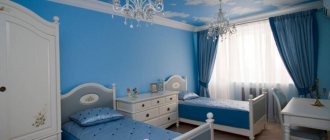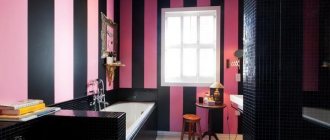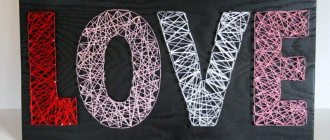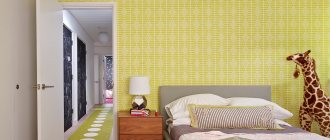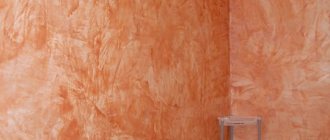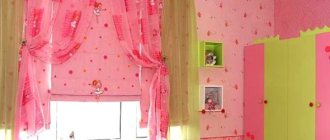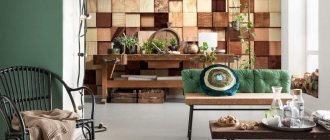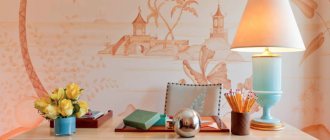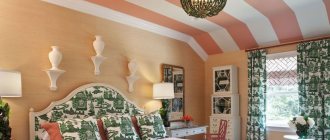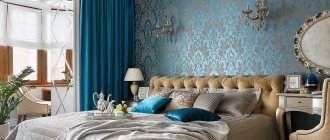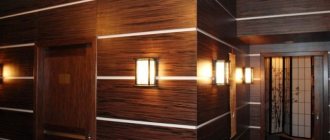Liquid, or “silk” wallpaper is a popular type of decorative covering for walls and ceilings. They combine all the advantages of plaster and ordinary paper wallpaper - they are suitable for walls of any configuration, are applied with a spatula, and after drying they acquire a soft texture.
The options for using liquid and regular wallpaper are completely identical. They are suitable for decorating an entire room or individual elements such as niches, rhizolites or openings. With the help of such decorative material, you can decorate the plane of the wall, visually enlarge the room and make it lighter, and perform color zoning. Read more about the features of liquid wallpaper and creating interiors with it in our article.
Liquid wallpaper
What is liquid wallpaper?
Liquid wallpaper in the interior is a mixture of cellulose of various sizes with dry glue. The composition contains textile fibers, which make the decorative coating soft to the touch. A mixture of pigments is used to color the composition.
Unlike conventional plaster, sand, cement and gypsum components are not used here. When working, all ingredients are mixed in certain proportions, which are indicated on the product packaging.
Finishing with liquid wallpaper: positive and negative sides
Like all finishing building materials, liquid wallpaper has its positive and negative sides. When choosing a coating, you should take some time and become familiar with its pros and cons.
Advantages:
- No seams. This result is achieved thanks to the texture and method of application.
- Environmentally friendly. The wallpaper is made from natural ingredients, and the surface on which it is applied can breathe.
- Possibility of partial repair or restoration.
- Neutral electric charge (contains only natural ingredients). Such wallpaper does not attract dust.
- Convenience when finishing hard-to-reach places (corners, ledges, bay windows, etc.)
- Versatility. Liquid wallpaper can be applied to almost any surface: concrete, drywall, wood, plaster, fiberboard, plywood, MDF, paint, metal, etc.
- Ensuring the heat and sound insulation properties of the surface on which they are applied.
- Duration of operation.
Flaws:
- The high cost of high-quality liquid wallpaper (“silk”).
- Possibility of washing off wallpaper with water (liquid wallpaper, if it is not varnished, cannot be wiped with a damp cloth).
Types of liquid wallpaper
Today, the building materials market offers a huge number of new liquid wallpaper products. In turn, they are divided into several types:
- Models with silk-screen printing. The product contains up to 50% silk threads, which after drying create a shiny texture. This option of decorative material is considered the most expensive among other types of liquid wallpaper;
- Paper and pulp. They are characterized by a short service life and the smallest amount of decorative materials. Their cost is much lower than that of silk models;
- Cotton. The presence of cotton particles makes the coating softer and more uniform;
- Models based on silk and cellulose. The composition uses silk and cellulose components;
- Moisture-resistant models. This type of decorative coating can be used to decorate a bathroom, bathhouse and even a sauna. These models use special additives that repel moisture and prevent its penetration into deep structures. The use of transparent acrylic varnish will help increase the water-repellent effect. To do this, it is enough to cover the walls with a thin layer to prolong the performance of the decorative coating. Caring for such walls is easy and simple. To do this, just wipe them with a soft cloth and soapy water.
Crumbs made of natural and artificial stone
Another type of decorative coating that is used to decorate the facades of buildings, as well as interior spaces, is stone chips.
The material is a mixture of small grains (pebbles) with binders and adhesive components. On sale, crumbs are usually presented in the form of a paste-like mass, packaged in buckets of various sizes.
Granite, marble and quartz chips are used as pebbles. To make the material more decorative, tinted dyes are added to the mixture of natural granules.
Modern manufacturers produce large-textured, medium-textured and fine-textured crumbs. The granules in the mixture have a calibrated size and a spherical shape.
Among the advantages of this decorative coating, one should note its stunning appearance, strength and durability. In addition, walls decorated with stone chips “breathe”, withstand temperature changes well, are not “afraid” of frost and heat, and do not show any unevenness or any flaws. It is very convenient that stone chips are perfectly applied to any surface: concrete, brickwork, drywall or plaster.
Among the relative “minuses” they note the impossibility of removing the old coating, which forms a real monolith with the base. So if the need for new repairs arises, the coating will have to be carefully puttied, and only then a new compound or paint will be applied directly over it.
Working with stone chips is easy:
- The base is puttied.
- Apply a primer (you can use either special compounds or any paint).
- Check the consistency of the working composition; if necessary, it can be diluted slightly with water.
- Using a spatula, apply the mixture evenly to the wall, removing excess.
Then let it dry for about 6-8 hours. The varnish is applied to the treated surface only after it has completely dried, after about one and a half to two weeks.
What substances are used for production?
To create this version of the finishing material, the following components are used:
- Adhesive base. This material is made in the form of a dry powder, which after contact with water increases in size and promotes adhesion of the decor to the concrete plane;
- Dyes. They allow you to paint the working composition in the required shade;
- Pulp of different sizes. For the production of liquid wallpaper, paper of different compositions and strengths is used. It is she who sets the texture and volume on the surface of the wall;
- Small fibers of silk threads. They provide the finished surface with shine and silky texture;
- Antiseptics and fungicides. These substances prevent the growth of bacteria and fungi on the surface;
- Decorative details in the form of mica, mother-of-pearl chips, sparkles of different diameters and mineral chips.
The material for decorating the interior space is sold in the form of a dry powder, which is pre-packaged in containers of different diameters. The shelf life of such finishing material is from 10 to 15 years.
How to make wallpaper from sawdust
The solution is prepared similarly to paper, only sawdust is used as a base.
Mix the raw material with water and leave to swell for 5-6 hours.
Add water, decorative fillers, glue and pigments to the swollen sawdust.
Mix the mixture thoroughly with a construction mixer and leave under the closed lid for about 12 hours.
Immediately before application, add gypsum to the finished mass and stir well until plastic.
Pros and cons of liquid wallpaper
What is better, liquid wallpaper or regular wallpaper? Experts highlight both the positive and negative aspects of this type of decorative coating. Benefits include:
- Easy and quick to apply. According to positive reviews of liquid wallpaper, the repair process does not exceed 10 hours;
- Does not accumulate dust. The product contains special additives that have a dust-repellent and moisture-proof coating;
- They have good thermal insulation. Such wallpaper reduces the occurrence of drafts;
- Environmentally friendly composition. As noted above, chemical components and toxic substances are not used to produce this model of finishing material;
- During the application process, no joints are formed and the decorations do not need to be combined with each other;
- They have good soundproofing qualities. Cellulose, in contact with polyvinyl chloride compounds, forms a dense shell on the surface of the wall, which perfectly absorbs loud sounds;
- Cracks do not appear even after prolonged use;
- Some types are excellent at absorbing moisture. For example, when choosing liquid wallpaper for the kitchen, you must take into account the presence of additional moisture-repellent impregnation. Its presence is indicated in the product composition. In the cooking area, there is always increased humidity and temperature changes, which negatively affect the condition of decorative coatings;
- They can be used to create three-dimensional images on the surface of the ceiling and walls. For example, when creating designs with liquid wallpaper, you will need a more dense composition. To do this, in the process of preparing the working composition, the proportions of water are reduced by one and a half times. In this way, a porridge-like substance is obtained, which is easy to create a three-dimensional texture or a peculiar pattern;
- Easily demonstrated. To do this, you can use a regular construction spatula. If deformations from animal nails appear on the wall, then a small amount of the composition can correct the situation and return the interior to its original appearance.
The disadvantages of liquid wallpaper include its long drying time and the ability to absorb excess moisture if the finishing material does not have additional moisture-repellent impregnation.
Liquid wallpaper: reviews, disadvantages of finishing material
Despite its many advantages, liquid wallpaper also has disadvantages. It is generally accepted that the coating obtained as a result of applying the material has moisture-resistant properties. However, this figure is not high enough, so liquid wallpaper cannot be compared with washable canvases. Experts, as well as manufacturers, do not recommend wet cleaning this type of finish.
Liquid wallpaper can have different structures and fillers, which allows you to choose the most suitable option for decorating the room
If dirt gets on the wall, the problem is solved as follows:
- The damaged area is moistened with water from a spray bottle and removed. You can use a spatula or knife for this.
- The surface in the repair area is treated with two layers of primer.
- The coating is restored by applying fresh material.
Consumers also note some shortcomings of the material in their reviews:
“I chose liquid wallpaper to decorate the walls in the apartment. The motivation was the environmental friendliness of the material, which is essentially natural fibers dyed a certain color and mixed with glue. In fact, it turned out that the coating has a very strong and strong smell. Moreover, the smell lasts for a very long time, as does the feeling of dampness in the room. I had to open the windows, but that didn’t help much either.”
Vitaly Golub, St. Petersburg
“Finally we finished renovating our house. We used liquid wallpaper on the recommendation of the store salesperson. Now I want to share my impressions. Firstly, the procedure for applying the material is not as simple as the manufacturer claims. Secondly, before diluting the material with water, you need to carefully check the condition of the walls and plaster on it. The fact is that at least 10-20 kg of finishing is applied to the wall. Not every plaster can withstand such weight. The coating itself turned out to be quite attractive, although, in my opinion, not as cozy as regular wallpaper.”
Sergey Vasnetsov, Moscow
In the case of preparing liquid wallpaper for application to a large surface, it is better to use a construction mixer to mix the composition
Helpful advice! If the design involves combining several types of liquid material, before work you need to apply markings to the walls, which will serve as a guide between different areas.
How much does liquid wallpaper cost: price is the main disadvantage of the material
Despite the fact that many buyers find the photos of liquid wallpaper found in catalogs attractive, not everyone is satisfied with the price of the material. Compared to traditional types of finishing, the cost of this coating is quite high. Without experience working with liquid material, you will also have to purchase several additional packages in order to properly master the technology.
Features and average prices of liquid wallpaper for walls:
| Manufacturer | Material advantages | Textural features | Manufacturer country | Consumption 1 pack/m² | price, rub. /pack |
| Silk Plaster | masking irregularities | Smooth, embossed | Russia | 3-4 | 920 |
| large selection of decorative additives | |||||
| UV resistance | |||||
| wide palette of shades | |||||
| Leroy Merlin | elastic covering | Smooth, embossed | France | 4,5 | 970 |
| no gaps or seams | |||||
| fast and easy application system | |||||
| Bioplast | surface repels dust | Embossed | Ukraine | 3,5 | 1050 |
| does not interfere with natural air circulation | |||||
| good maintainability | |||||
| high level of sound and thermal insulation |
Features of preparing walls for liquid wallpaper and their application
The preparatory stage is the most important component of finishing work, because the final result depends on the quality of the base. The process of preparing the solution is not particularly difficult, but it takes a lot of time. To do this, just pour the cellulose material into the container and, adding water, mix thoroughly to obtain a homogeneous mass. The procedure is done manually. After the material is mixed, it is placed back into the packaging or plastic bag, where it is left until it ripens.
In case of using smooth liquid wallpaper. the surface must be properly leveled using putty
Preparing the base is a complex stage of finishing work, which involves:
- repairing defects (chips, cracks);
- plane leveling;
- brightening the surface using white dye.
It will be necessary to apply a primer under the liquid wallpaper, as well as on each applied layer of material. This process takes a lot of time. This will take several days, because each layer needs to be thoroughly dried before further work can begin. It is worth considering that putty dries on average 24-30 hours, and primer 24 hours.
Note! Each package of liquid wallpaper is mixed separately. It is not advisable to pour several bags of dry material into one container at once. If you add color, you should carefully monitor the ratio of the coloring composition, as well as other decorative components and the amount of wallpaper.
In order to extend the service life of liquid wallpaper, the surface must be primed before application.
How long liquid wallpaper dries depends not only on the manufacturer, but also on other conditions:
- temperature and humidity conditions;
- quality of base preparation;
- base material;
- composition of the mixture (presence of polymer, mineral or metallized fillers);
- presence of drafts.
The drying process of wallpaper can last from 2 days to 3 weeks. The duration also depends on the base material. Liquid wallpaper dries fastest if plasterboard sheets, sand-lime plaster (layer thickness 1-2 cm) or sand-lime brick are chosen as the base.
Liquid wallpaper application technology
How to apply liquid wallpaper? Experts have developed several methods for applying the working composition to a vertical and horizontal plane. They include:
- To finish the ceiling, use a flat spatula. A small amount of the working composition is applied to it. Next, the decorations are evenly distributed in a circular motion. The surface is first carefully treated to remove external defects and primed;
- For finishing the kitchen, we recommend purchasing an additional supply of consumables. The corner parts of the space are treated with the working composition. Movements are carried out from bottom to top;
- To treat plasterboard structures, the entire frame is puttied with a finishing mixture. After this, it can be coated with acrylic paint.
Liquid wallpaper consumption
What is the price and consumption of liquid wallpaper per square meter? Experts recommend spending an average of 1 sq.m. 0.5 kg of dry composition. The purchase price directly depends on the area of the room and the presence of external effects.
For an even surface you will need from 0.3 to 0.5 kg. It is also necessary to take into account the inclination and movements of the spatula during the application of the working composition to the walls. For example, if you hold a construction spatula at an angle of 45 degrees, then approximately 0.2 kg will be consumed during application.
Application technique
Although manufacturers say that liquid wallpaper can be applied to curved walls, it is better not to do this. There are two points. The first is increased material consumption. Considering that the cost of liquid wallpaper is not too low (one package per 4-5 m² is required, and it costs from 5 to 18 $, although there are also 40 $), it is cheaper to prepare the surface. The second point is that if there are significant differences, pronounced “spotting” may result. Darker areas will be where liquid wallpaper is applied in a thick layer, and lighter areas where the layer is thin (due to the wall being translucent). This again leads to an increase in consumption - to even out the color.
It's better to level the wall
Surface preparation
First of all, you need to remove the old decorative coating. We peel off the wallpaper to the bare wall, and remove the paint if it bubbles and peels off. Then we smooth out the unevenness. As has already been said, it is better to make the wall at least more or less even.
A flat (or relatively flat) wall must be coated with primer several times. This will reduce the absorbency of the surface, making it easier to work.
The difference in color between the dried and freshly applied mass is large
Based on experience, liquid wallpaper is best applied to rough walls, such as plaster. So, it is desirable that the primer gives a similar effect. Of the ready-made compositions, this is “Betonokontakt”. After applying it, the wall becomes a little “sticky” in feel; grains of sand stuck to the surface make it rough. Any composition fits perfectly on such a base. There is also a cheaper option for priming walls for liquid wallpaper - the most inexpensive white water-based emulsion (2 parts) with PVA glue (1 part). It is necessary to cover with primer (any kind) at least twice.
If the wall has an uneven color, and the primer did not hide it, you will also have to paint it. Because when applying a thin layer, darker and lighter areas will show through. You can take the most inexpensive water-based paint and paint the wall with it. A perfectly even color is not needed; there should be no sharp transitions.
Several types of liquid wallpaper. It is high in silk fibers
One more thing. If there are metal fragments in the wall - nails, screws, etc., it is advisable to remove them. If you can't remove it, paint the area with some kind of water-repellent paint in the same color as the base. If this is not done while the liquid wallpaper is drying, the metal will rust, and the rust will “come out” as an unsightly yellow spot. It will have to be repaired immediately. So it is better to insulate all metal objects in advance.
Preparation of the composition
Liquid wallpaper is sold dry in bags. Before use, add water to the composition and mix everything well. The amount of water depends on the volume of the bag, the type of composition, and the manufacturer. The specific quantity is written on the package.
It is more convenient for this work to have a large plastic bucket - 12 liters or more. Pour the contents of the bag into it and add water. The mixture must be stirred until smooth. It turns out something similar to minced meat.
Add water to the dry mixture of liquid wallpaper and mix everything well
Since liquid wallpaper does not contain harmful chemical additives, you can mix it with your hands. If the mass is unpleasant to you, you can wear gloves. The finished mass is usually transferred back into the bag, screwed on the “neck” and left for several hours (at least 4-5 hours, but better 10-12) - for uniform swelling. Please note that the dried composition will be noticeably lighter than the wet one.
Even the sulfur color is not boring at all
It is better to mix at once the entire amount needed to finish a room or at least one wall. If you put it in “pieces,” the borders may be visible. They are almost invisible in light shades, but can ruin the picture if the color is bright. If the boundaries are still visible until the wall is completely dry, you should not take any action. It is possible that the borders will disappear when completely dry. If the liquid wallpaper has dried, but transitions are visible, the composition can be removed with a spatula, soaked again for several hours, mixed and applied again.
Application to wall or ceiling
Take a new trowel for the job. To make it easier to monitor the process, there is a trowel with a transparent plastic working surface. This trowel makes it easier for beginners to work with. The process itself is simple:
- The soaked composition is applied in a small amount to the surface.
- Rub it on the wall in a circular motion.
- They put in a new batch of material and continue from the previous place.
It's better to start from the top and work your way down
It is advisable to process the entire wall at once, otherwise the junction lines of the two “pieces” may be visible. If you still weren’t able to treat the entire wall at once, spray the joint well with water, wait 20-25 minutes, and you can continue finishing. Most likely, the joint will be subtle or almost invisible.
In the corners you can use a regular spatula, but it is easier to make even corners using special corner spatula. First, apply the mixture on both sides of the corner, apply it with a corner spatula, and rub the excess squeezed out from the corner onto the wall, leveling the surface.
Liquid wallpaper takes a long time to dry - about 48 hours. The composition contains a significant amount of water, so when it dries in the room there is high humidity, which inevitably gets into other rooms. But in the process you can turn on the heating, open the windows, create a draft. There are no restrictions.
Application by roller
Applying liquid wallpaper using a trowel or spatula is good for everyone, except that the process takes a lot of time. To speed up the process, you can try applying liquid wallpaper with a roller. Only the roller must be special: with hard short hairs collected in groups. The width is about 15 cm. If you can’t find one, you can use fur with hard short pile or foam rubber, but hard.
Tool for applying liquid wallpaper
Before starting work, dilute liquid wallpaper according to the instructions and prepare the wall. Then try working with the resulting composition. If the mass is poorly distributed on the wall, add a little water. But add a little at a time, because too liquid will “slip.” The technique is slightly different:
- Apply a certain amount of mass to the wall with a spatula, without worrying too much about the thickness of the layer. Just make a “blunder”.
- Roll out using a roller.
- Apply the next batch of solution and roll out.
Using a roller makes it easier to maintain the same thickness of the material. This works well on flat walls. Moreover, the finishing speed is 6-8 m².
Different application techniques give different effects
When applying liquid wallpaper with a roller, the surface becomes rougher and more textured. If you don’t like this effect, after the wall is finished, moisten it with a spray bottle, wait about 15 minutes, go over the surface with a clean trowel soaked in water, smoothing out the relief.
How to make patterns with liquid wallpaper
Beginners are unlikely to be able to make complex patterns on walls with liquid wallpaper, but it’s quite possible to try something simple. The easiest way to make two-color patterns, and simpler ones are geometric ones.
Any image can be found. But then you need to transfer the outline of the drawing to the wall. If you have artistic abilities, you can try to do it by hand. If that doesn’t work, you can enlarge it to the required size, print it on paper, but preferably on cardboard, cut it out and attach it to the wall. Fill around with one color of wallpaper. When the liquid wallpaper has dried, remove the paper/cardboard, using the second one to fill the empty area. But you need to work carefully, without dirtying the finished part.
After removing the paper or cardboard template, a depression remains, which is filled with material of a different color
If the design is simple - geometric shapes, for example, you can install some kind of rigid barrier to separate the colors. For example, beacons for plaster. They are fixed and filled with liquid wallpaper of the same color. After drying, you can remove the beacons and carefully, without crawling onto the finished part, use the second color.
There is also a way to transfer complex drawings without printing. You will need glass, a black marker, and a lamp. Draw an outline on the glass with a black felt-tip pen and highlight it with a lamp. A clear outline appears on the wall, which we simply draw. We fill it in the way that is most convenient, but usually first large areas, then smaller ones.
Liquid wallpaper at home
How to make liquid wallpaper with your own hands? Today, the assortment of construction stores offers a huge number of finishing and consumable materials. However, many consumers prefer to create this type of decor at home. What will be needed to create a workforce? This list includes:
- Paper. To prepare the building composition, you can use absolutely any type of cellulose. The paper base is first crushed into small pieces;
- Next, we use color pigments, dry polyvinyl chloride, glitter, silk fibers and pearlescent powder;
- Mix all components thoroughly with each other. Then add water. The consistency should be similar to thick sour cream.
If the decorative base begins to peel off, then experts recommend adding more adhesive base. If cracks appear, filler must be replenished. The photo of liquid wallpaper shows the result of decorating a vertical coating.
How to work with liquid wallpaper?
How to apply liquid wallpaper yourself? To do this, it is recommended to adhere to the following instructions:
- First, place the contents of the package in a deep container;
- Next, add the required volume of water indicated on the package;
- After which it is recommended to properly prepare the wall. To do this, all irregularities are removed using putty;
- Now, using a construction spatula, carefully distribute the working composition at an angle of 45 degrees. In this way, it is possible to reduce the consumption of decorative coating;
- The temperature in a closed space should be between 18 and 20 degrees. If it is lower, the risks of detachments and external deformations increase;
- When applying a decorative coating, the entire surface is carefully worked with a rubber flat spatula. In this way, it is possible to create a perfectly level base for further finishing.
Features of wall decoration
You can hang liquid wallpaper with your own hands, but for high-quality finishing and especially for creating drawings, it is better to contact a specialist. The preparation of walls takes place in several stages: you need to remove the old coating, cover strong defects with plaster, and apply two layers of primer. If you choose light-colored wallpaper for the interior, you should even out the color of the base. The dry mixture is diluted with water. If the kit contains decorative additives, such as glitter, colored inclusions or fibers, they should be poured into the bottom of the working container first.
Mixture for liquid wallpaper
Recommended proportions of liquid and powder are indicated by the manufacturer on the packaging, and they may vary depending on the composition. Some mixtures can be tinted independently using water-based colors. It must be remembered that this will significantly complicate the repair and restoration of the coating in the future - choosing a perfectly accurate tone is quite difficult. The material diluted with water should be left for 10-12 hours: this way its consistency will become uniform and more convenient to work with.
The coating is applied in the same way as plaster - with a wide spatula. For mixtures with fine particles or for stencil designs, it is better to use a construction hopper gun. With such a spray gun, finishing will take a minimum of time; it is more convenient to use for finishing ceilings and curved surfaces. In addition, spraying helps reduce material consumption by almost 2 times.
How to apply liquid wallpaper
The thickness of the finish depends on the consistency of the mixture: it is better to apply homogeneous compositions in a layer of 1-2 mm, cotton “compositions” with fibrous inclusions - 2-4 mm. After a couple of hours, you need to carefully work the surface of the wall with a spatula or roller, smoothing the coating. The finish dries within 1-3 days, preferably with the windows open so that moisture can escape faster. Unlike ordinary wallpaper, liquid wallpaper is not afraid of drafts. The main thing is that the room temperature does not fall below +10 degrees; in winter it is worth taking care of additional heating. The finished coating will sit perfectly after drying, regardless of the wall configuration.
Finishing with liquid wallpaper
Dyeing process
If, after finishing the walls with liquid wallpaper, designers are not satisfied with the color, then this defect can be corrected by painting the walls. For work, water-based types of coloring compositions are used. They are well absorbed into the porous structure and make the surface uniform.
To apply coloring pigments, use a wide brush. This type of tool allows you to paint over voids and minor imperfections well. During the dyeing process, you should not make sudden movements. The fact is that coloring pigments penetrate deeply into the cellulose structure, thereby provoking its destruction.
Photo of liquid wallpaper in the interior
Share the post “Liquid wallpaper in the interior: 140 photos of design, ideal design and color combination” by copying the link: https://kaksdelatsvoimirukami.ru/zhidkie-oboi-v-interere-140-foto/
Areas of use
The areas of use of liquid wallpaper are very extensive. They are used as finishing coatings in residential and administrative buildings, offices, beauty salons and hotel rooms. Thanks to the large selection of wallpaper colors, this building material is considered universal. Bright shades are suitable for large rooms. Light and warm colors are a great choice for small apartments.
Important : liquid wallpaper is a salvation for those who have moved into new buildings. Everyone knows the fact that over time the foundation of a new house shrinks. There are many unpleasant moments associated with this. For example, regular wallpaper may come off the wall or even tear. By using liquid wallpaper as a coating, most of the above problems can be avoided.
Please note : theoretically, liquid wallpaper can be applied to the walls of the bathroom and kitchen. However, then you will have to use colorless varnish as a special fixing and protective coating. Unfortunately, there are no varnishes made exclusively from natural ingredients. In addition, the effect of “breathing” walls will disappear. Take these nuances into account before gluing liquid wallpaper in rooms with high humidity.
